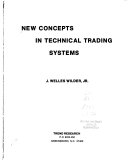Fickle followers of fashion: Who, and why, do they choose to move on?
Many moons ago I remember the morning my colleague, Mariella Cassar, brought a book into the office at Midland Bank, City of London. She was clearly very excited about it and wanted to share – and discuss – some of its contents with our small technical analysis team. The book was: ‘New Concepts in Technical Trading Systems’ by J. Welles Wilder, Jr, first published in 1978 by Hunter Publishing Company, Winston-Salem, North Carolina.
Once we had shared the book what struck us most was the mathematical precision of many of the studies he had devised (maybe not surprising as he was a mechanical engineer). In his introduction Mr Wilder states: ‘the programmable calculator, due to its relative inexpensive cost, is readily becoming an indispensable tool for the technical trader. All of the systems and indexes in this book can be programmed on most of the programmable calculators currently available’.
We happily set about storing some of his models on our trusty Hewlett Packard scientific calculators. Today, with the development of ever more powerful computational power and the media focus on artificial intelligence, I’m wondering why few seekers of the ultimate trading model don’t use his ideas that much.
His Relative Strength Index has been totally mainstream for decades while Directional Movement and Parabolic are used by a few. However his Pivot Points (and associated support and resistance levels) have fallen out of favour.
The five-point system uses the following equations:
Pivot point (P) = (Previous High + Previous Low + Previous Close)/3.
S1= (P x 2) – Previous high.
S2 = P – (Previous High – Previous Low)
R1 = (P x 2) – Previous Low.
R2 = P + (Previous High – Previous Low)
These price levels used to be considered key when publishing professional technical analysis daily information sheets.
Also interesting is to note that other charting methods give greater or lesser importance to different price points. For example, candlestick charts focus on the real body, rather than the whiskers at either end, so much so that often trend lines are drawn excluding these extremities. Conversely Ichimoku candles use the mid-point of the period’s price action.
Similarly Market Profile histograms focus on price levels where most market activity has been concentrated. Plain old bar charts have always emphasized the importance of volume relative to price action – and open interest where available.
Tags: Mathematical models, outliers, Real Body, volume
The views and opinions expressed on the STA’s blog do not necessarily represent those of the Society of Technical Analysts (the “STA”), or of any officer, director or member of the STA. The STA makes no representations as to the accuracy, completeness, or reliability of any information on the blog or found by following any link on blog, and none of the STA, STA Administrative Services or any current or past executive board members are liable for any errors, omissions, or delays in this information or any losses, injuries, or damages arising from its display or use. None of the information on the STA’s blog constitutes investment advice.
Latest Posts
- Mastering Relative Strength Portfolios: Key Takeaways from the March STA Meeting March 12, 2025
- Stay Disciplined, Stay Profitable February 26, 2025
- Understanding Price Gaps in Trending February 19, 2025
- Key Takeaways from a Fireside Chat with Perry Kaufman February 12, 2025
- The Power of Patience: How Waiting for the Right Setups Can Make or Break Your Trading Success February 3, 2025





















Latest Comments